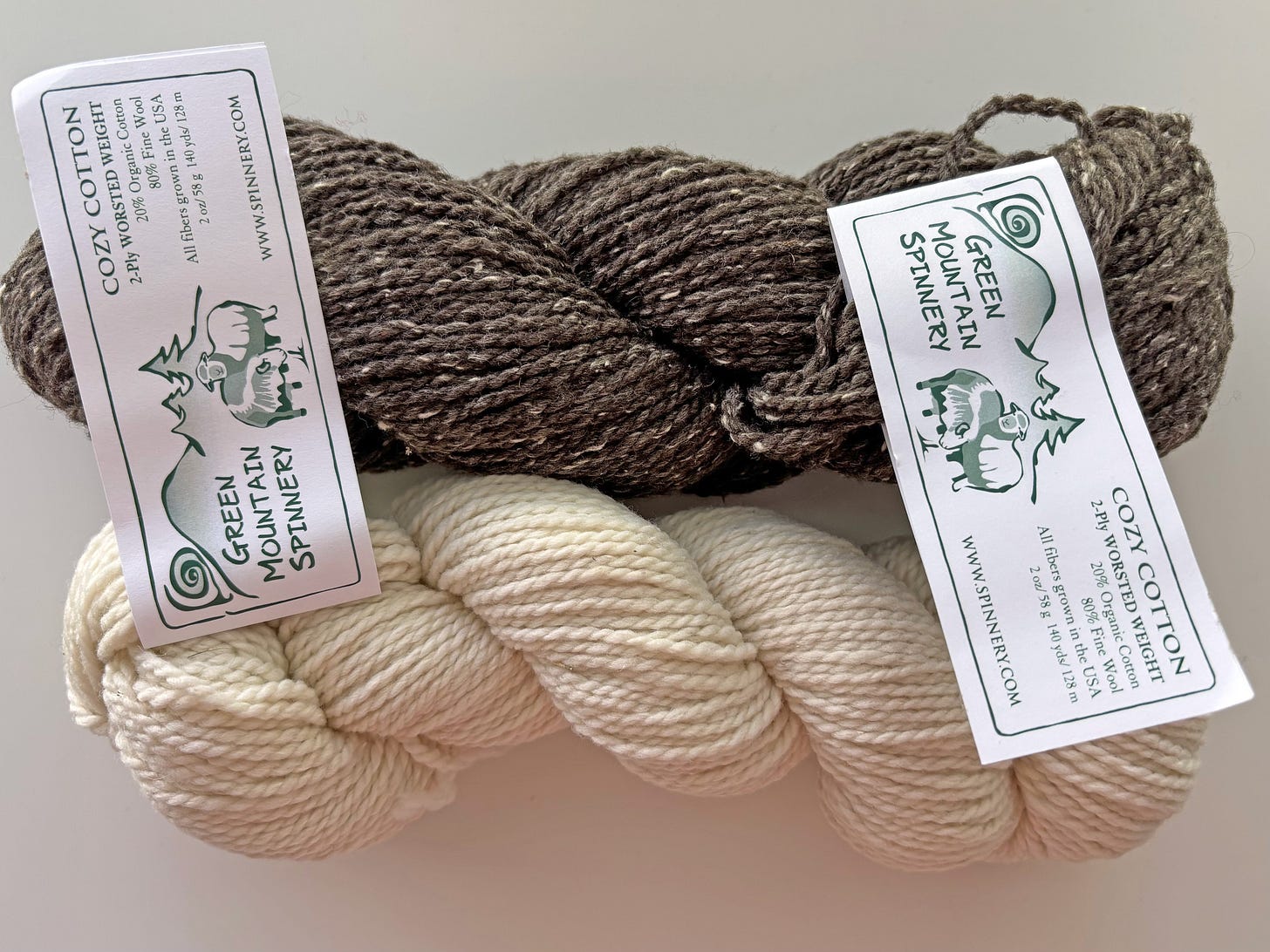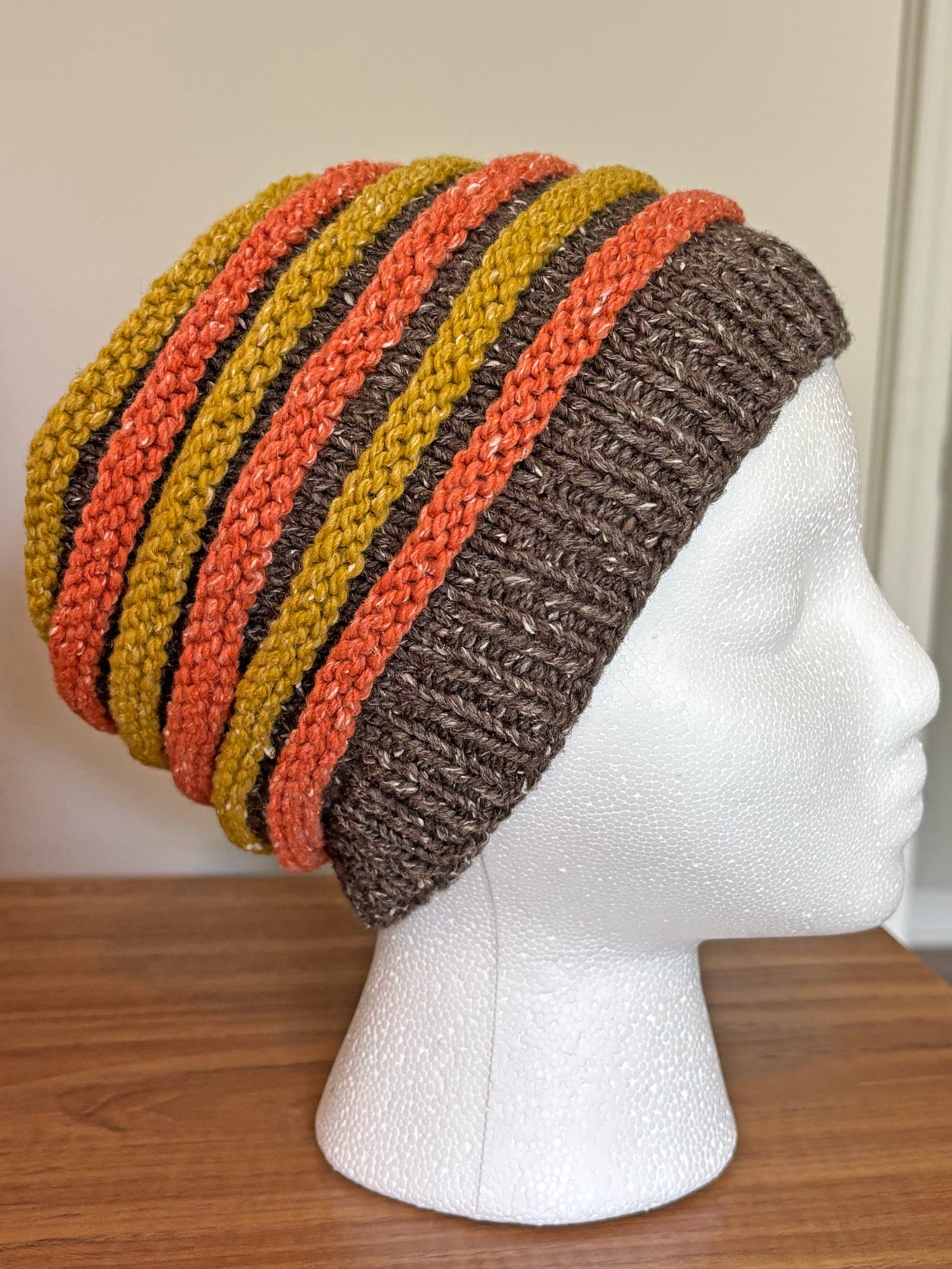Some of my favorite sweaters were made with yarns that blend cotton and wool together. So, when The Green Mountain Spinnery asked if I was interested in designing with their new-ish Cozy Cotton, I was quick to say YES! (Literally. I used all caps and an exclamation point in the email.) I’ve spent the past three weeks with this yarn on my needles, and I’m eager to tell you all about it.
FYI: This yarn was gifted to me by The Green Mountain Spinnery along with the assignment to create new designs. I am under no obligation to review the yarn. The links are not affiliate links, and I receive no compensation for this review (other than from those of you who are paid subscribers 🩷.) I have an ongoing business relationship with The Green Mountain Spinnery tech editing their patterns.
First, the Specifications
Cozy Cotton is suitable for use in patterns calling for worsted weight yarn.
Let’s Take a Closer Look
Cozy Cotton is a 2-ply yarn. The undyed cotton fibers are swirled into the dyed wool, not evenly blended, so the flecks of white give the yarn a tweedy appearance. Each ply has enough twist to keep it from drifting apart, and the two plies are twisted together gently. The yarn is soft, light, and lofty. I can easily break the yarn with my hands, but it doesn’t require gentle handling while knitting.
In the course of swatching and knitting a sweater, I wound and knit a total of 11 skeins of this yarn. The yarn is evenly and consistently spun. There were no slubs or thin spots. The fiber has been gently processed, so I wasn’t surprised to find a moderate amount of vegetable matter (VM) in the yarn—a souvenir of the land and sheep that produced the fiber. Whenever a bit of VM pokes my fingers, whether while winding the yarn into balls or while knitting, I pick it out.
Each skein had one (and only one) mill knot. I don’t consider the occasional knot to be a problem. Sometimes yarn breaks in the spinning and winding process, and tying a knot reduces waste. But I never trust a mill knot. The ends on mill knots are usually clipped short to reduce the chance of snagging in the machinery. I don’t want to risk having a knot come undone the first time I wash the finished sweater. When I encounter a knot, I cut it out and join the yarn just as I would a new ball.
Let’s Look at a Swatch
My stockinette stitch swatch was knit on size US 7 (4.5 mm) needles. My gauge is 18 sts and 28 rows = 4" (10 cm). This matches the gauge suggested by the yarn label.
Cozy Cotton is a pleasure to knit. The yarn is bouncy and resilient. It has no tendency to split. I could easily knit with my eyes closed.
The stitch definition is clear. The fabric has a slightly irregular appearance due to the texture of the yarn. This swatch has a lot of body; a sweater knit with Cozy Cotton will hold its shape well over time. It’s not going to stretch out of shape or get droopy.
Cozy Cotton would make a fantastic casual pullover or a comfortable everyday cardigan. It would also be great for a blanket or throw.
Speaking of Blankets…
Knit in garter stitch, Cozy Cotton feels plush yet sturdy. I went up to a size US 8 (5 mm) needle for this mitered square. My gauge in garter stitch is 17 sts and 34 rows = 4" (10 cm). A square like this could be the start of a throw your family would snuggle under with a bowl of popcorn on movie night.
The Colors
Cozy Cotton is currently offered in eight colors. All are flecked with white from the undyed cotton. The Spinnery is expecting two more colors (a deep red and a sage green) to be available soon. All the colors are just a bit “off” from what you might expect: Dusty Rose is a vibrant cool pink leaning toward purple, and Pomelo is golden yellow with a green undertone. They combine to make a cheerful yet sophisticated palette.
What You Can’t See
The wool in this yarn is Targhee from herds grazed along the Front Range of the Rocky Mountains. Targhee is one of my favorite wools to spin and knit. The breed was developed in the 1920’s by the United States Department of Agriculture Sheep Experiment Station in Idaho. They bred Rambouillet rams with Corriedale and Lincoln/Rambouillet cross ewes. The breed was named after the National Forest where the flock grazed in the summer months. Targhee sheep produce soft, fine wool with a well-defined crimp. This crimp makes the yarn lively, airy, and resilient.
The organic cotton in this yarn comes from Texas. Texans lead the US in the development of organic cotton farming, producing fiber with a much lighter environmental footprint than conventionally grown cotton.
Blended together, these fibers create a yarn worthy of Goldilocks: warm, lightweight, durable, soft against the skin, and environmentally responsible.
Of Course I Made a Hat, and You Can, Too
As I often do when exploring a new yarn, I knit a hat. This design is great for using up bits and pieces of leftover yarn. You can knit it all in one color, use two contrasting colors as I did, or making every ridge a different color.
My hat was knit on size US 8 (5 mm) needles, and measures 20" (51 cm) in circumference. The gauge is 18 sts = 4".
I cast on 90 stitches. To adjust the size, add or subtract in multiples of 10 stitches. At this gauge, every 10 stitches will make a 2¼" difference in the size.
Work in K1, P1 ribbing for about 1½".
Now start the 8-round Ridge Pattern:
Rounds 1–4: With main color, knit.
Round 5: With contrasting color, knit.
Rounds 6–8: With contrasting color, purl.
Work Rnds 1–8 a total of six times (or more, if you have enough yarn and you’re feeling whimsical.)
Now shape the crown, using the main color only:
Knit 2 rounds, then knit another round placing 10 stitch markers evenly spaced around. For my 90-stitch hat, I placed a marker after every 9th stitch.
Decrease round: * Knit to 2 sts before marker, knit 2 together; repeat from * to end of round—10 stitches decreased.
Repeat Decrease round every 3rd round two more times, then every other round three times, then every round until there are ten stitches left.
Break yarn and thread tail through remaining stitches. Pull tight to close top of hat and fasten off. Weave in your ends and enjoy your hat!
The Bottom Line
I’ve reviewed other wool/cotton blends in the past. Green Mountain Spinnery Cozy Cotton is a thicker alternative to both of those. It is a true worsted-weight, not DK or light worsted.
Cozy Cotton gets bonus point for being entirely produced in the USA, meaning it won’t be subjected to tariffs. Buying this yarn supports American farmers, ranchers, and manufacturing. What’s not to love?
Things that caught my eye…
I look forward to
’s Cultivating Color newsletter every Friday morning. “I’m an attention artist making marks in watercolor.” Reading Lorene regularly will train your eye to notice the kaleidoscope of colors that surround you.I’m not a big country music fan, but this lyric is my current earworm:
Life's a dance you learn as you go
Sometimes you lead, sometimes you follow
Don't worry about what you don't know
Life's a dance you learn as you goWritten by Allen Shamblin and Steve Seskin, recorded by John Michael Montgomery
Let’s all keep dancing, learning the steps as we go!
I had a book recommendation all ready for this week, but this post was getting long. I’m betting you’d rather have the little hat pattern instead of a book recommendation.
Thank you, as always, for your attention and support. I love sharing my world of knitting and books with you. And if you are one of the hundreds of new subscribers(!) (what magic is this?) who joined up this week, welcome. I’m delighted you’ve found your way to this little alcove of the internet.
Continue the conversation: I usually knit with fingering, sport, and DK weight yarns. But fingering weight yarn makes up the bulk of my stash. How about you? Do you gravitate toward a particular yarn weight? Is the yarn you “collect” consistent with the yarn you most often use? Tell me about it in the comments.











Thank you for the detailed review! The info you provide is wonderful. And special thanks for the hat pattern. I love the design. You know, I can’t keep my weights straight. Let’s just say I’m happiest when I’m knitting with sizes 5-7 needles 🙂
I really appreciate your reviews.
I am dk or lighter in yarn weight preference. I have to grab something different occasionally to use a different needle size, or knit a loose fabric.